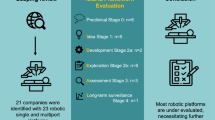Abstract
Background/Purpose
The initial idea behind natural orifice transluminal endoscopic surgery (NOTES) was that of an incisionless surgery. NOTES cholecystectomy is a good model of human ingenuity and technological advance. NOTES cholecystectomy in a human being was performed at our institution after extensive laboratory work in live pig models. In this process we gained helpful information related to NOTES cholecystectomy.
Methods
More than 250 cholecystectomies in pigs have been performed. From May 2007 to November 2008 a total of 10 and 6 transvaginal and transgastric human cholecystectomies, respectively, have been performed.
Results
The procedure was successful in all patients, with a mean operative time of 120 min. There were no intraoperative or postoperative complications. Patients recovered promptly after surgery and had minor postoperative pain. They were discharged on the second postoperative day.
Conclusions
The advantages of laparoscopy appeared to be enhanced by this approach: patients had minor postoperative pain and minimal scarring. This stepwise experience in the cholecystectomy procedure is an important first step in the development of methods and devices to enable the evaluation of potential incisionless NOTES surgery. Additional research and comparison studies are needed for further improvement in order to provide NOTES procedures to a wider range of patients.




Similar content being viewed by others
References
ASGE/SAGES Working Group on Natural Orifice Translumenal Endoscopic Surgery. White Paper October 2005. Gastrointest Endosc 2006;63:199–203.
Leroy J, Cahill RA, Peretta S, Marescaux J. Single port sigmoidectomy in an experimental model with survival. Surg Innov. 2008;15:260–5.
Pai RD, Fong DG, Bundga ME, Odze RD, Rattner DW, Thompson CC. Transcolonic endoscopic cholecystectomy: a NOTES survival study in a porcine model (with video). Gastrointest Endosc. 2006;64:428–34.
Rolanda C, Lima E, Pego JM, Henriques-Coelho T, Silva D, Moreira I, et al. Third-generation cholecystectomy by natural orifices: transgastric and transvesical combined approach (with video). Gastrointest Endosc. 2007;65:111–7.
Perretta S, Dallemagne B, Coumaros D, Marescaux J. Natural orifice transluminal endoscopic surgery: transgastric cholecystectomy in a survival porcine model. Surg Endosc. 2008;22:1126–30.
Marescaux J, Dallemagne B, Perretta S, Wattiez A, Mutter D, Coumaros D. Surgery without scars: report of transluminal cholecystectomy in a human being. Arch Surg. 2007;142:823–6. (discussion 826–827).
Gallstones and laparoscopic cholecystectomy. NIH Consens Statement. 1992 Sep 14–16;10(3):1–20.
Scott DJ, Tang SJ, Fernandez R, Bergs R, Goova MT, Zeltser I, et al. Completely transvaginal NOTES cholecystectomy using magnetically anchored instruments. Surg Endosc. 2007;21:2308–16.
Nassif J, Zacharopoulou C, Marescaux J, Wattiez A. Transvaginal extraperitoneal lymphadenectomy by natural orifices transluminal endoscopic surgery (NOTES) technique in porcine model: feasibility and survival study. Gynecol Oncol. 2009;112(2):405–8.
Ghezzi F, Raio L, Mueller MD, Gyr T, Buttarelli M, Franchi M. Vaginal extraction of pelvic masses following operative laparoscopy. Surg Endosc. 2002;16:1691–6.
Forgione A, Maggioni D, Sansonna F, Ferrari C, Di Lernia S, Citterio D, et al. Transvaginal endoscopic cholecystectomy in human beings: preliminary results. J Laparoendosc Adv Surg Tech A. 2008;18:345–51.
Abe N, Takeuchi H, Ueki H, Matsuoka H, Yanagida O, Masaki T, et al. Cholecystectomy by a combined transgastric and transparietal approach using two flexible endoscopes. J Hepatobiliary Pancreat Surg. 2009;16(1):25–30.
von Delius S, Gillen S, Doundoulakis E, Schneider A, Wilhelm D, Fiolka A, et al. Comparison of transgastric access techniques for natural orifice transluminal endoscopic surgery. Gastrointest Endosc. 2008;68:940–7.
Sumiyama K, Gostout CJ. Techniques for transgastric access to the peritoneal cavity. Gastrointest Endosc Clin N Am. 2008;18:235–44. vii.
Swanstrom L, Zheng B. Spatial orientation and off-axis challenges for NOTES. Gastrointest Endosc Clin N Am. 2008;18:315–24. ix.
Voermans RP, Worm AM, van Berge Henegouwen MI, Breedveld P, Bemelman WA, Fockens P. In vitro comparison and evaluation of seven gastric closure modalities for natural orifice transluminal endoscopic surgery (NOTES). Endoscopy. 2008;40:595–601.
McGee MF, Marks JM, Onders RP, Chak A, Jin J, Williams CP, et al. Complete endoscopic closure of gastrotomy after natural orifice translumenal endoscopic surgery using the NDO Plicator. Surg Endosc. 2008;22:214–20.
Magno P, Giday SA, Dray X, Chung SS, Cotton PB, Gostout CJ, et al. A new stapler-based full-thickness transgastric access closure: results from an animal pilot trial. Endoscopy. 2007;39:876–80.
Acknowledgments
The authors would like to express their appreciation of and admiration for the expert work of Alain Rohfritsch and Elena Mihalache (animal laboratory) and Catherine Cers (medical illustration), IRCAD/EITS, Strasbourg, France.
Author information
Authors and Affiliations
Corresponding author
About this article
Cite this article
Asakuma, M., Perretta, S., Allemann, P. et al. Challenges and lessons learned from NOTES cholecystectomy initial experience: a stepwise approach from the laboratory to clinical application. J Hepatobiliary Pancreat Surg 16, 249–254 (2009). https://doi.org/10.1007/s00534-009-0089-3
Received:
Accepted:
Published:
Issue Date:
DOI: https://doi.org/10.1007/s00534-009-0089-3




